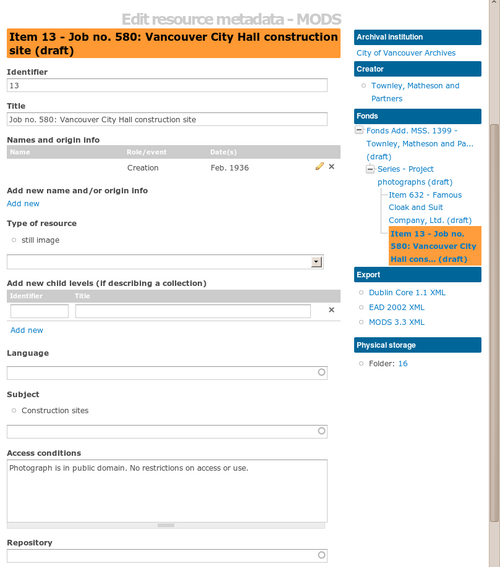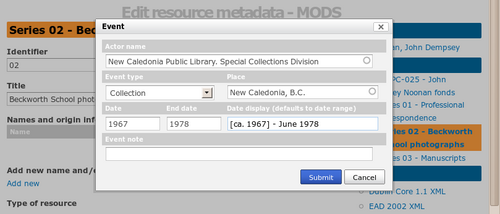Difference between revisions of "MODS"
| Line 43: | Line 43: | ||
=== Event type === | === Event type === | ||
| − | *Select the type of event from the [[Glossary#Drop-down menu|drop-down menu]] | + | *Select the type of event from the [[Glossary#Drop-down menu|drop-down menu]]. |
* The [[Glossary#Value list|value list]] is drawn from the event types [[Glossary#Taxonomy|taxonomy]] and can be edited by system [[Glossary#Administrator|administrators]] and [[Glossary#Editor|editors]] (some terms in this taxonomy, however, are locked because they are accessed by the software code). | * The [[Glossary#Value list|value list]] is drawn from the event types [[Glossary#Taxonomy|taxonomy]] and can be edited by system [[Glossary#Administrator|administrators]] and [[Glossary#Editor|editors]] (some terms in this taxonomy, however, are locked because they are accessed by the software code). | ||
| − | |||
=== Place === | === Place === | ||
Revision as of 17:54, 1 June 2010
Please note that ICA-AtoM is no longer actively supported by Artefactual Systems.
Visit https://www.accesstomemory.org for information about AtoM, the currently supported version.
Main Page > User manual > Add/edit content > Add/edit archival descriptions > MODS elements
Identifier
Corresponds to "identifier" top level element.
MODS suggests values: "hdl, doi, isbn, isrc, ismn, issn, issue number, istc, lccn, local, matrix number, music publisher, music plate, sici, uri, upc, videorecording identifier, stock number."
Title
Corresponds to "title" sub-element in "titleInfo" top level element.
Names and origin info (incuding dates)
Corresponds to "name" and "originInfo" top level elements.
Events in ICA-AtoM
ICA-AtoM manages date ranges as events that links an actor (corporate body, person, or family), described in an authority record, to an archival unit in a type of role (e.g. creator, publisher, contributor, collector, broadcaster, etc.) over a certain period of time. At the highest level of description, the archival unit should always be associated with its creator over the date range of the material. At lower levels of description, enter the date range only to inherit the creator from the higher level (i.e. a description will inherit the creator if "Actor name" is left blank). At any level you can associate a description with multiple creators over different date ranges. At any level you can assign multiple types of relations; this will be primarily useful at the item level (e.g. date of publication vs creation).
Add a new event
- Under "Names and origin info" click the blue Add new link to add a new event.
- Enter data in the dialogue box as described below. When you are done, click "Submit".
Actor name
- In the Actor name field enter the first few letters of the the actor's name. A list of names will appear in the drop-down menu (generated from the names of existing authority records).
- If the name does not appear in the menu, type the name and a new authority record will be created.
- Note that you can leave the Actor name field fields blank. Lower levels inherit creator information from higher levels: use only if the creator is different at the lower and higher levels.
- At the highest level of description, you should always include the creator.
Event type
- Select the type of event from the drop-down menu.
- The value list is drawn from the event types taxonomy and can be edited by system administrators and editors (some terms in this taxonomy, however, are locked because they are accessed by the software code).
Place
- Select the place of creation, contribution or publication, if relevant, by typing in the first few letters and then selecting the place from the drop-down menu. If the place name does not appear on the list, type it in and a new place term will be created.
- To add new place terms, you must edit the places taxonomy; for editing taxonomies, see add a new term.
Date/End date
- Enter the Date (i.e. start year) and End date.
- If the start and end years are the same, enter only in the "Date" field and leave the "End date" blank.
- Complete at lower levels of description even if you are leaving the creator name field blank (e.g. when describing a series, you do not need to repeat the creator name from the fonds description, but you do need to enter the date range of the series).
- Do not use any qualifiers here (e.g. "ca.") or typographical symbols (e.g. "[194?]") to express uncertainty (see step 4).
Date display
- If desired, enter the date range as you want it to appear in view mode.
- Add any additional text to qualify date range (e.g. "ca. 1940-1980" or "[1940]-1980, predominant 1973-1980").
- Whereas "Date" and "End date" are used internally for database searching and sorting purposes, this field is for display purposes. However, if you do not enter anything into "Date display" the "Date" and "End date" will appear as a date range when the record is saved.
Event note
- Enter any additional information relating to the event.
Type of resource
Corresponds to "typeOfResource" top level element.
The DCB provides a data entry field using a drop-down menu to select type derived from the MODS resource type taxonomy based on the MODS list of enumerated values for this field.
This taxonomy can be edited by administrators and editors on the list taxonomy terms page.
If the term you want to use does not appear on the menu, you (or your system administrator or editor) must first add it to the taxonomy.
For more on editing terms and adding to taxonomies, see add/edit terms.
Add new child levels
See add a new archival description
Language
Corresponds to "language" top level element.
ICA-AtoM implements this as a drop-down menu. The user may select as many languages as desired.
Click on the field and select the language from the drop-down menu. To narrow the list of choices, enter the first few letters of the language.
Subject
Corresponds to "subject" top level element.
Click on the "Subject" field and select a term from the drop-down menu. You can narrow the list of choices by entering the first few letters of the term.
The values in the subject drop-down menu are drawn from the subjects taxonomy. ICA-AtoM does not ship with any pre-loaded subject terms.
This taxonomy can be edited by administrators and editors on the list taxonomy terms page.
If the subject you want to use does not appear on the menu, you (or your system administrator or editor) must first add it to the taxonomy.
For more on editing terms and adding to taxonomies, see add/edit terms.
Access conditions
Corresponds to "accessCondition" to level element.
MODS suggests values: "restriction on access; use and reproduction."
Repository
Select a repository only at the highest level of description; leave this field blank at the lower levels if they are all held by the same repository. It is important to remember this because if a repository is selected for the lower levels then these lower levels will all be displayed in the holdings area of an archival institution's context menu.
Click on the "Repository" field and select the archival institution that holds the archival material being described. The names are drawn from pre-existing archival institution records. You can narrow down the list of choices by typing in the first few letters of the name.
If the repository does not appear in this list, you can type it in and a new repository record will be created.


